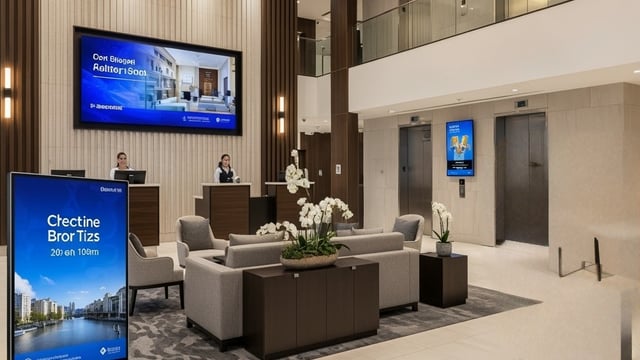
Today’s hotel guests expect more than comfort — they expect connectivity, personalization and tech-forward convenience. A recent survey found that 72% of guests are more likely to return to a hotel that offers their preferred technology, underscoring how critical it is for properties to align with evolving digital expectations. As hotels navigate tightening budgets and heightened guest expectations, smart displays are becoming a vital component in transforming the hospitality environment—both front and back of the house.
Even amid economic uncertainty, hoteliers are prioritizing technology—planning to increase investments by an average of 16% in the coming year. This trend presents an opportunity for IT leaders to re-evaluate how display technologies—often seen as static tools—can act as dynamic engines for operational efficiency and enhanced guest satisfaction.
From Static Screens to Smart Interfaces
In-room displays once served primarily for entertainment. But when integrated with AI, sensors, and connected room systems, they evolve into multifunctional, interactive control hubs.
Hotel CIOs and CTOs are increasingly deploying AI-driven displays that can adapt to guest preferences in real time. In fact, 60% of luxury hotels have already implemented AI-powered smart room automation. From automating check-ins and dimming lights, to responding to voice requests and pushing location-based concierge content, these interfaces are becoming a bridge between physical comfort and digital service.
Enabling Smart Room Ecosystems
As the backbone of connected environments, displays allow guests to personalized lighting, temperature, curtain control and in-room dining—all from a single intuitive display interface. This integration eliminates the need for multiple remotes or confusing wall switches, while also delivering valuable usage data that hotel IT teams can harness to refine operations.
For instance, data on preferred room temperature and lighting patterns can inform energy-saving strategies or be used to fine-tune future guest stays. Smart HVAC automation systems that adjust settings based on real-time occupancy data have been shown to reduce energy costs by up to 30%, . For properties aiming to meet sustainability goals, this level of data-driven control is a win—improving guest comfort while supporting environmental stewardship.
Virtual Concierge Services: 24/7 Without the Overhead
Interactive displays placed in lobbies or in rooms can provide multilingual support, local dining recommendations, loyalty program details, or directions to nearby attractions. For hotels experiencing staffing shortages or managing multiple properties remotely, this is a reliable way to provide information around the clock.
This also opens the door to personalization on a scale. IT leaders can design content pipelines tailored to different guest segments—business travelers, families or international tourists—based on booking profiles and real-time analytics.
Empowering Business Travelers to Stay Productive
A WIRED study showed that 62% of respondents value mobility and accessibility for daily business, with hotels ranking among the top locations for remote work. For hotels that cater to this audience, upgrading displays in rooms and shared workspaces can significantly enhance the guest experience. Whether offering docking capabilities or screen sharing for virtual meetings, these enhancements transform guest rooms into functional workplaces, which can be the deciding factor in winning repeat customers.
In addition, hotels that host on-site events or small conferences can streamline AV logistics by standardizing smart displays across their properties, reducing the need for costly equipment rentals or technician support. In fact, 77% of business travelers and 64% of employed Americans believe the return of business travel is more important than ever, so it is important to ensure a consistent and efficient experience to earn repeat business.
Behind the Scenes: Supporting Staff and Operations
While guest-facing innovations often take center stage, some of the most transformative gains are happening behind the scenes. In enterprise hospitality, delivering a seamless guest experience depends heavily on operational precision—how quickly service requests are resolved, how well housekeeping is coordinated, and how effectively large teams collaborate.
From digital signage in staff areas to real-time task boards for housekeeping and maintenance, displays can act as visual command centers. When integrated with workflow platforms, these tools help maintain service consistency. As many properties continue to operate with leaner teams, hotel operations can benefit from having clear, real-time visibility into occupancy rates, turnover timelines and room service status—data that smart displays can surface on command. Such efficiencies are not just helpful—they’re essential.
The Bottom Line for IT Leaders
For hotel CIOs, CTOs and IT VPs, displays are no longer passive tools—they are the digital backbone of next-generation hospitality that can drive both top-line revenue and bottom-line savings. As investments in property technology rise, IT leaders have a chance to reshape how guests interact with their environments—and how their teams manage the business behind the scenes.






